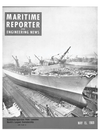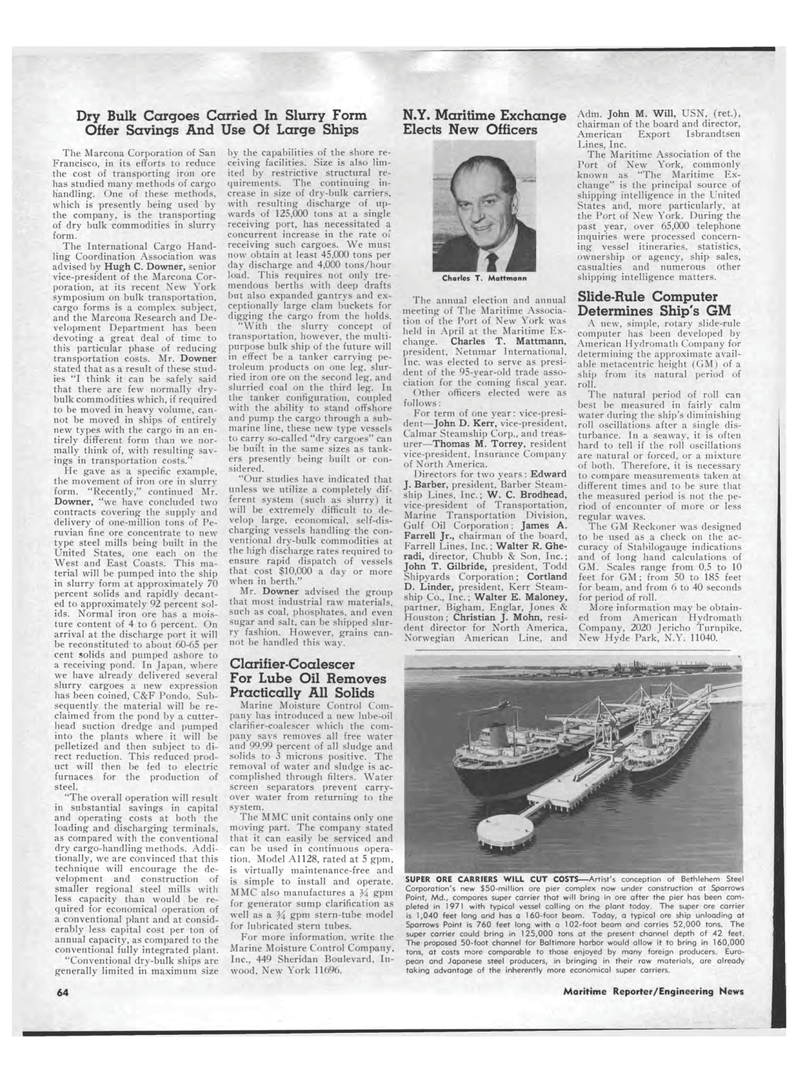
Page 60: of Maritime Reporter Magazine (May 15, 1969)
Read this page in Pdf, Flash or Html5 edition of May 15, 1969 Maritime Reporter Magazine
Dry Bulk Cargoes Carried In Slurry Form Offer Savings And Use Of Large Ships N.Y. Maritime Exchange Elects New Officers The Marcona Corporation of San Francisco, in its efforts to reduce the cost of transporting iron ore has studied many methods of cargo handling. One of these methods, which is presently being used by the company, is the transporting of dry bulk commodities in slurry form. The International Cargo Hand-ling Coordination Association was advised by Hugh C. Downer, senior vice-president of the Marcona Cor-poration, at its recent New York symposium on bulk transportation, cargo forms is a complex subject, and the Marcona Research and De-velopment Department has been devoting a great deal of time to this particular phase of reducing transportation costs. Mr. Downer stated that as a result of these stud-ies "I think it can be safely said that there are few normally dry-bulk commodities which, if required to be moved in heavy volume, can-not be moved in ships of entirely new types with the cargo in an en-tirely different form than we nor-mally think of, with resulting sav-ings in transportation costs." He gave as a specific example, the movement of iron ore in slurry form. "Recently," continued Mr. Downer, "we have concluded two contracts covering the supply and delivery of one-million tons of Pe-ruvian fine ore concentrate to new type steel mills being built in the United States, one each on the West and East Coasts. This ma-terial will be pumped into the ship in slurry form at approximately 70 percent solids and rapidly decant-ed to approximately 92 percent sol-ids. Normal iron ore has a mois-ture content of 4 to 6 percent. On arrival at the discharge port it will be reconstituted to about 60-65 per cent solids and pumped ashore to a receiving pond. In Japan, where we have already delivered several slurry cargoes a new expression has been coined, C&F Pondo. Sub-sequently the material will be re-claimed from the pond by a cutter-head suction dredge and pumped into the plants where it will be pelletized and then subject to di-rect reduction. This reduced prod-uct will then be fed to electric furnaces for the production of steel. "The overall operation will result in substantial savings in capital and operating costs at both the loading and discharging terminals, as compared with the conventional dry cargo-handling methods. Addi-tionally, we are convinced that this technique will encourage the de-velopment and construction of smaller regional steel mills with less capacity than would be re-quired for economical operation of a conventional plant and at consid-erably less capital cost per ton of annual capacity, as compared to the conventional fully integrated plant. "Conventional dry-bulk ships are generally limited in maximum size by the capabilities of the shore re-ceiving facilities. Size is also lim-ited by restrictive structural re-quirements. The continuing in-crease in size of dry-bulk carriers, with resulting discharge of up-wards of 125,000 tons at a single receiving port, has necessitated a concurrent increase in the rate of receiving such cargoes. We must now obtain at least 45.000 tons per day discharge and 4,000 tons/hour load. This requires not only tre-mendous berths with deep drafts but also expanded gantrys and ex-ceptionally large clam buckets for digging the cargo from the holds. "With the slurry concept of transportation, however, the multi-purpose bulk ship of the future will in effect be a tanker carrying pe-troleum products on one leg, slur-ried iron ore on the second leg, and slurried coal on the third leg. In the tanker configuration, coupled with the ability to stand offshore and pump the cargo through a sub-marine line, these new type vessels to carry so-called "dry cargoes" can be built in the same sizes as tank-ers presently being built or con-sidered. "Our studies have indicated that unless we utilize a completely dif-ferent system (such as slurry) it will be extremely difficult to de-velop large, economical, self-dis-charging vessels handling the con-ventional dry-bulk commodities at the high discharge rates required to ensure rapid dispatch of vessels that cost $10,000 a day or more when in berth." Mr. Downer advised the group that most industrial raw materials, such as coal, phosphates, and even sugar and salt, can be shipped slur-ry fashion. However, grains can-not be handled this way. Clarifier-Coalescer For Lube Oil Removes Practically All Solids Marine Moisture Control Com-pany has introduced a new lube-oil clarifier-coalescer which the com-pany says removes all free water and 99.99 percent of all sludge and solids to 3 microns positive. The removal of water and sludge is ac-complished through filters. Water screen separators prevent carry-over water from returning to the system. The MMC unit contains only one moving part. The company stated that it can easily be serviced and can be used in continuous opera-tion. Model A1128, rated at 5 gpm, is virtually maintenance-free and is simple to install and operate. MMC also manufactures a Y\ gpm for generator sump clarification as well as a Y\ gpm stern-tube model for lubricated stern tubes. For more information, write the Marine Moisture Control Company, Inc., 449 Sheridan Boulevard, In-wood, New York 11696. Charles T. Mattmann The annual election and annual meeting of The Maritime Associa-tion of the Port of New York was held in April at the Maritime Ex-change. Charles T. Mattmann, president, Netumar International, Inc. was elected to serve as presi-dent of the 95-year-old trade asso-ciation for the coming fiscal year. Other officers elected were as follows: For term of one year: vice-presi-dent?John D. Kerr, vice-president, Calmar Steamship Corp., and treas-urer?Thomas M. Torrey, resident vice-president. Insurance Company of North America. Directors for two years: Edward J. Barber, president. Barber Steam-ship Lines, Inc.; W. C. Brodhead, vice-president of Transportation, Marine Transportation Division, Gulf Oil Corporation; James A. Farrell Jr., chairman of the board, Farrell Lines, Inc.; Walter R. Ghe-radi, director, Chubb & Son, Inc.; John T. Gilbride, president, Todd Shipyards Corporation; Cortland D. Linder, president, Kerr Steam-ship Co., Inc.; Walter E. Maloney, partner, Bigham, Englar, Jones & Houston; Christian J. Mohn, resi-dent director for North America, Norwegian American Line, and Adm. John M. Will, USN, (ret.), chairman of the board and director, American Export Isbrandtsen Lines, Inc. The Maritime Association of the Port of New York, commonly known as "The Maritime Ex-change" is the principal source of shipping intelligence in the United States and, more particularly, at the Port of New York. During the past year, over 65,000 telephone inquiries were processed concern-ing vessel itineraries, statistics, ownership or agency, ship sales, casualties and numerous other shipping intelligence matters. Slide-Rule Computer Determines Ship's GM A new, simple, rotary slide-rule computer has been developed by American Hydromath Company for determining the approximate avail-able metacentric height (GM) of a ship from its natural period of roll. The natural period of roll can best be measured in fairly calm water during the ship's diminishing roll oscillations after a single dis-turbance. In a seaway, it is often hard to tell if the roll oscillations are natural or forced, or a mixture of both. Therefore, it is necessary to compare measurements taken at different times and to be sure that the measured period is not the pe-riod of encounter of more or less regular waves. The GM Reckoner was designed to be used as a check on the ac-curacy of Stabilogauge indications and of long hand calculations of GM. Scales range from 0.5 to 10 feet for GM ; from 50 to 185 feet for beam, and from 6 to 40 seconds for period of roll. More information may be obtain-ed from American Hydromath Company, 2020 Jericho Turnpike, New Hyde Park, N.Y. 11040. ?Him SUPER ORE CARRIERS WILL CUT COSTS?Artist's conception of Bethlehem Steel Corporation's new $50-million ore pier complex now under construction at Sparrows Point, Md., compares super carrier that will bring in ore after the pier has been com-pleted in 1971 with typical vessel calling on the plant today. The super ore carrier is 1,040 feet long and has a 160-foot beam. Today, a typical ore ship unloading at Sparrows Point is 760 feet long with a 102-foot beam and carries 52,000 tons. The super carrier could bring in 125,000 tons at the present channel depth of 42 feet. The proposed 50-foot channel for Baltimore harbor would allow it to bring in 160,000 tons, at costs more comparable to those enjoyed by many foreign producers. Euro-pean and Japanese steel producers, in bringing in their raw materials, are already taking advantage of the inherently more economical super carriers. 64 Maritime Reporter/Engineering News

 59
59

 61
61
